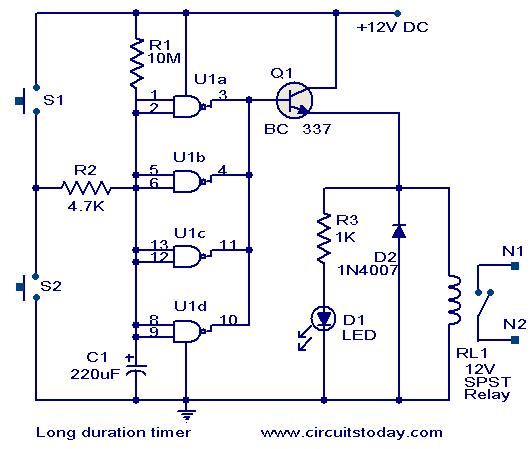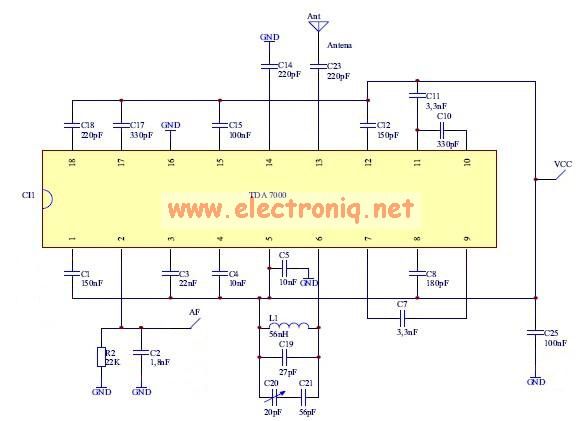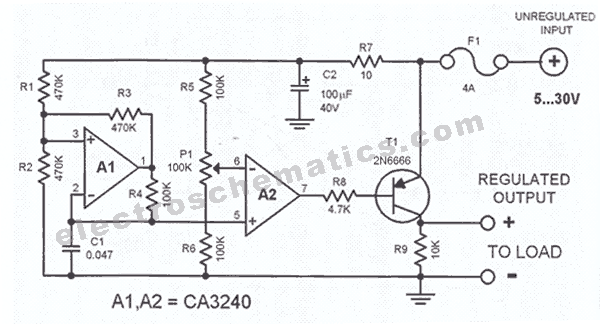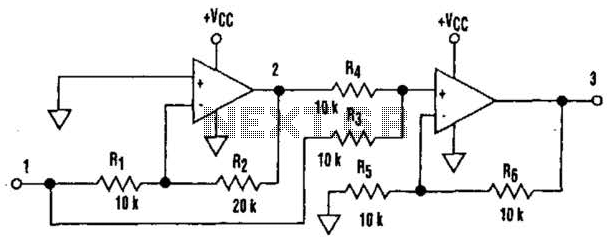
Voltmeter circuit
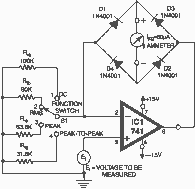
A high-input-resistance op-amp, a bridge rectifier, a microammeter, and a few other discrete components are all that are required to realise this versatile circuit. This circuit can be used for measurement of dc, ac rms, ac peak, or ac peak-to-peak voltage by simply changing the value of the resistor connected between the inverting input terminal of the op-amp and ground. The voltage to be measured is connected to non-inverting input of the op-amp. The full-scale deflection of the universal high-input-resistance voltmeter circuit shown in the figure depends on the function switch position as follows: (a) 5V dc on position 1 (b) 5V ac rms in position 2 (c) 5V peak ac in position 3 (d) 5V ac peak-to-peak in position 4 The circuit is basically a voltage-to-current converter. The design procedure is as follows: Calculate RI according to the application from one of the following equations: (a) dc voltmeter: RIA = full-scale EDC/IFS (b) rms ac voltmeter (sine wave only): RIB = 0.9 full-scale ERMS/ IFS (c) Peak reading voltmeter (sine wave only): RIC = 0.636 full-scale EPK/IFS (d) Peak-to-peak ac voltmeter (sine wave only): RID = 0.318 full-scale EPK-TO-PK / IFS The term IFS in the above equations refers to meter's full-scale deflection current rating in amperes. It must be noted that neither meter resistance nor diode voltage drops affects meter current.
The described circuit is a versatile measurement device capable of accurately gauging various types of voltage signals, including direct current (DC), root mean square (RMS) alternating current (AC), peak AC, and peak-to-peak AC voltages. At its core, the circuit employs a high-input-resistance operational amplifier (op-amp) to ensure minimal loading on the measurement source, thus preserving the integrity of the voltage being measured.
The circuit topology includes a bridge rectifier, which converts AC signals into a usable DC format for the microammeter, allowing for direct reading of the measured voltage. The microammeter serves as the output display, providing a visual indication of the voltage level being measured. The configuration of the op-amp in a voltage-to-current converter mode is crucial for translating the input voltage to a corresponding current that drives the microammeter.
The user can select the measurement type by adjusting a function switch, which alters the circuit's configuration to accommodate different voltage types. Each position of the switch is calibrated for a specific measurement range, allowing for full-scale deflection of 5V for each measurement type. The equations provided for calculating the resistor values (RI) are essential for tailoring the circuit to specific applications, ensuring accurate readings based on the voltage type and desired full-scale deflection.
In the case of DC measurements, the resistor value is determined directly from the full-scale DC voltage and the full-scale current rating of the microammeter (IFS). For AC measurements, the calculations take into consideration the RMS value for sine waves, with specific coefficients applied to account for the nature of the AC signal. This versatility in measurement capabilities, coupled with straightforward calibration procedures, makes the circuit an invaluable tool for electrical engineers and technicians engaged in voltage measurement tasks.
It is important to note that the performance of the circuit remains unaffected by the resistance of the microammeter or any voltage drops across the diodes in the bridge rectifier, ensuring accurate current readings regardless of these factors. This design consideration further enhances the reliability and precision of the measurement circuit in practical applications.A high-input-resistance op-amp, a bridge rectifier, a microammeter, and a few other discrete components are all that are required to realise this versatile circuit. This circuit can be used for measurement of dc, ac rms, ac peak, or ac peak-to-peak voltage by simply changing the value of the resistor connected between the inverting input terminal of the op-amp and ground.
The voltage to be measured is connected to non-inverting input of the op-amp. The full-scale deflection of the universal high-input-resistance voltmeter circuit shown in the figure depends on the function switch position as follows: (a) 5V dc on position 1 (b) 5V ac rms in position 2 (c) 5V peak ac in position 3 (d) 5V ac peak-to-peak in position 4 The circuit is basically a voltage-to-current converter. The design procedure is as follows: Calculate RI according to the application from one of the following equations: (a) dc voltmeter: RIA = full-scale EDC/IFS (b) rms ac voltmeter (sine wave only): RIB = 0.9 full-scale ERMS/ IFS (c) Peak reading voltmeter (sine wave only): RIC = 0.636 full-scale EPK/IFS (d) Peak-to-peak ac voltmeter (sine wave only): RID = 0.318 full-scale EPK-TO-PK / IFS The term IFS in the above equations refers to meter?s full-scale deflection current rating in amperes.
It must be noted that neither meter resistance nor diode voltage drops affects meter current. 🔗 External reference
The described circuit is a versatile measurement device capable of accurately gauging various types of voltage signals, including direct current (DC), root mean square (RMS) alternating current (AC), peak AC, and peak-to-peak AC voltages. At its core, the circuit employs a high-input-resistance operational amplifier (op-amp) to ensure minimal loading on the measurement source, thus preserving the integrity of the voltage being measured.
The circuit topology includes a bridge rectifier, which converts AC signals into a usable DC format for the microammeter, allowing for direct reading of the measured voltage. The microammeter serves as the output display, providing a visual indication of the voltage level being measured. The configuration of the op-amp in a voltage-to-current converter mode is crucial for translating the input voltage to a corresponding current that drives the microammeter.
The user can select the measurement type by adjusting a function switch, which alters the circuit's configuration to accommodate different voltage types. Each position of the switch is calibrated for a specific measurement range, allowing for full-scale deflection of 5V for each measurement type. The equations provided for calculating the resistor values (RI) are essential for tailoring the circuit to specific applications, ensuring accurate readings based on the voltage type and desired full-scale deflection.
In the case of DC measurements, the resistor value is determined directly from the full-scale DC voltage and the full-scale current rating of the microammeter (IFS). For AC measurements, the calculations take into consideration the RMS value for sine waves, with specific coefficients applied to account for the nature of the AC signal. This versatility in measurement capabilities, coupled with straightforward calibration procedures, makes the circuit an invaluable tool for electrical engineers and technicians engaged in voltage measurement tasks.
It is important to note that the performance of the circuit remains unaffected by the resistance of the microammeter or any voltage drops across the diodes in the bridge rectifier, ensuring accurate current readings regardless of these factors. This design consideration further enhances the reliability and precision of the measurement circuit in practical applications.A high-input-resistance op-amp, a bridge rectifier, a microammeter, and a few other discrete components are all that are required to realise this versatile circuit. This circuit can be used for measurement of dc, ac rms, ac peak, or ac peak-to-peak voltage by simply changing the value of the resistor connected between the inverting input terminal of the op-amp and ground.
The voltage to be measured is connected to non-inverting input of the op-amp. The full-scale deflection of the universal high-input-resistance voltmeter circuit shown in the figure depends on the function switch position as follows: (a) 5V dc on position 1 (b) 5V ac rms in position 2 (c) 5V peak ac in position 3 (d) 5V ac peak-to-peak in position 4 The circuit is basically a voltage-to-current converter. The design procedure is as follows: Calculate RI according to the application from one of the following equations: (a) dc voltmeter: RIA = full-scale EDC/IFS (b) rms ac voltmeter (sine wave only): RIB = 0.9 full-scale ERMS/ IFS (c) Peak reading voltmeter (sine wave only): RIC = 0.636 full-scale EPK/IFS (d) Peak-to-peak ac voltmeter (sine wave only): RID = 0.318 full-scale EPK-TO-PK / IFS The term IFS in the above equations refers to meter?s full-scale deflection current rating in amperes.
It must be noted that neither meter resistance nor diode voltage drops affects meter current. 🔗 External reference
Warning: include(partials/cookie-banner.php): Failed to open stream: Permission denied in /var/www/html/nextgr/view-circuit.php on line 713
Warning: include(): Failed opening 'partials/cookie-banner.php' for inclusion (include_path='.:/usr/share/php') in /var/www/html/nextgr/view-circuit.php on line 713
